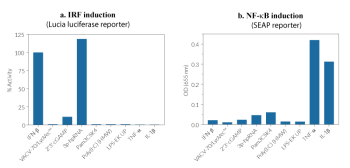HepG2-Dual™ Cells
-
Cat.code:
hepg2d-nfis
- Documents
This product is for internal research use for non-profit recipients only
ABOUT
NF-κB-SEAP & IRF-Lucia reporter liver carcinoma cells
The human hepatocellular carcinoma cell line HepG2 is widely used for in vitro studies of infection with hepatitis viruses (except HBV & HCV) and other hepatotropic pathogens such as Human Cytomegalovirus, Dengue Virus, Brucella, and Listeria [1, 2].
HepG2-Dual™ cells are designed for the study of NF-κB and IRF (interferon regulatory factor) pathways. NF-κB activation can be assessed by measuring secreted embryonic alkaline phosphatase (SEAP) activity, while the IRF pathway can be monitored by following Lucia luciferase activity.
Anti-viral and anti-bacterial immune responses mostly rely on the recognition of viral nucleic acids by cytosolic Toll-like receptors (TLRs), cytosolic RIG-I-like receptors (RLRs), and cytosolic DNA sensors (CDS). The TLR expression and activation profile of HepG2 cells are still poorly characterized, but it is established that HepG2 cells express the RIG-I and MDA-5 RNA sensors [2,3]. Although they do not express the cyclic GMP-AMP synthase (cGAS) cytosolic DNA sensor, these cells express low levels of its adaptor protein, STING (stimulator of interferon genes, also known as MITA) [4]. A moderate IRF response is detected in HepG2-Dual™ cells upon incubation with STING agonists such as 2’3’-cGAMP, while the 3p-hpRNA RIG-I agonist, induces a strong IRF response.
Both SEAP and Lucia luciferase reporter proteins are readily measurable in the cell culture supernatant when using QUANTI-Blue™ Solution and QUANTI-Luc™ 4 Lucia/Gaussia, respectively.
References:
1. Gural N. et al. 2017. Engineered livers for infectious diseases. Cell Mol Gastroenterol Hepatol. 5:131-44.
2. Yin X. et al. 2017. Hepatitis E virus persists in the presence of a type III interferon response PLoS Pathog. 13(5):e1006417.
3. Sato S. et al. 2015. The RNA sensor RIG-I dually functions as an innate sensor and direct antiviral factor for hepatitis B virus. Immunity. 42(1):123-32.
4. Dansako H. et al., 2016. The cyclic GMP-AMP synthetase-STING signaling pathway is required for both the innate immune response against HBV and the suppression of HBV assembly. FEBS J. 2283(1):144-56.
Disclaimer: These cells are for internal research use only and are covered by a Limited Use License (See Terms and Conditions). Additional rights may be available.
SPECIFICATIONS
Specifications
SEAP and Lucia® activity
Complete EMEM (see TDS)
Verified using Plasmotest™
Each lot is functionally tested and validated.
CONTENTS
Contents
-
Product:HepG2-Dual™ Cells
-
Cat code:hepg2d-nfis
-
Quantity:3-7 x 10^6 cells
- 1 ml Zeocin® (100 mg/ml)
- 1 ml Blasticidin (10 mg/ml)
- 1 ml Normocin™ (50 mg/ml), a formulation of three antibiotics active against mycoplasmas, bacteria, and fungi
- 1 ml of QB reagent and 1 ml of QB buffer (sufficient to prepare 100 ml of QUANTI-Blue™ Solution)
- 1 tube of QUANTI-Luc™ 4 Reagent (sufficient to prepare 25 ml)
Shipping & Storage
- Shipping method: Dry ice
- Liquid nitrogen vapor
- Upon receipt, store immediately in liquid nitrogen vapor. Do not store cell vials at -80°C.
Storage:
Caution:
DOCUMENTS
Documents
Technical Data Sheet
Validation Data Sheet
Safety Data Sheet
Certificate of analysis
Need a CoA ?








